Why is the sound distorted on my Panasonic SC-HT340?
- CChristina ChavezSep 7, 2025
If the sound is distorted on your Panasonic Home Theater System, it may be because noise may occur when playing WMA files.
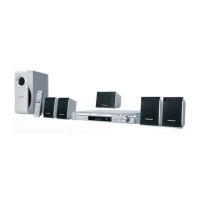
Why is the sound distorted on my Panasonic SC-HT340?
If the sound is distorted on your Panasonic Home Theater System, it may be because noise may occur when playing WMA files.
Why are the effects not working on my Panasonic SC-HT340 Home Theater System?
If the effects do not work on your Panasonic Home Theater System, it may be because some audio effects do not work or have less effect with some discs. Dolby Pro Logic II also does not work if you have changed the play speed.
Why are folders on my Panasonic SC-HT340 data CD not displayed correctly?
If folders on a data CD are not displayed correctly on your Panasonic Home Theater System, it is because folders deeper than the eighth layer are displayed as the eighth layer.
Why does a menu screen appear during skip or search on Panasonic SC-HT340?
If a menu screen appears during skip or search on your Panasonic Home Theater System, this is normal for Video CDs.
Why can't I add markers on my Panasonic Home Theater System?
You cannot add markers to DVD-RAM or DVD-R/RW (DVD-VR) discs on your Panasonic Home Theater System. If the disc’s elapsed play time does not appear on the unit’s display, you cannot add markers.
Why is humming heard during play on my Panasonic SC-HT340?
If humming is heard during play on your Panasonic Home Theater System, it may be because an AC mains lead or fluorescent light is near the main unit.
| Brand | Panasonic |
|---|---|
| Model | SC-HT340 |
| Category | Home Theater System |
| Language | English |
Identifies the model number of the DVD Home Theater Sound System.
Lists supported media formats like DVD-RAM, DVD-Video, and DivX.
Describes features like program search, audio selections, and zoom.
Highlights sound effects like SFC and Dolby Pro Logic II.
Warns about potential hazardous radiation exposure from the laser.
Advises against exposing the unit to rain, moisture, or liquids to prevent fire hazards.
Emphasizes proper ventilation to prevent overheating and fire hazards.
Crucial safety warning regarding the earth terminal connection for the AC mains lead.
Provides instructions on how to safely replace the fuse in the AC mains plug.
Advises on optimal placement for the unit, considering environmental factors.
Warns against using high voltage or DC power sources to prevent fire or overload.
Details how to protect the AC mains lead from damage to prevent electric shock or fire.
Advises to prevent metal objects or liquids from entering the unit to avoid shock or malfunction.
Lists all included accessories like remote control, AC lead, antennas, and batteries.
Lists precautions for battery usage and guidance on remote control operation.
Guides on speaker placement for optimal bass and sound field, including proximity to walls.
Refers to page 10 for additional speaker setup configurations.
Provides advice for setting up main unit, center, and subwoofer speakers, plus cautions.
Guides on connecting the AC mains lead and speakers after all other connections are made.
Advises on saving power by unplugging the unit when not in use for a long time.
Instructions on connecting the unit to the household mains socket.
Details how to connect speaker cables, emphasizing polarity and avoiding short circuits.
Instructions for connecting AM loop and FM indoor antennas.
Guides on connecting the unit to the TV via SCART, advising against using a VCR.
Explains how to improve picture quality by selecting S-Video or RGB output.
Details options for wall-mounting speakers and using outdoor antennas.
Information on DualDiscs and a list of discs that cannot be played.
Details the various disc formats supported by the unit, including DVD, CD, WMA, MP3, etc.
Explains PAL and NTSC video systems and conversion options.
Advises on how to handle discs to prevent damage and ensure playback.
Describes the controls and indicators on the main unit.
Details the functions of each button on the remote control.
Explains the sleep timer function for automatic unit turn-off.
Describes how to use the muting function.
Step-by-step guide to performing the initial quick setup process.
Lists and explains the available settings like Menu Language, TV Type, TV Aspect, AV Output.
Step-by-step guide to basic playback using the main unit controls.
Explains how to use the remote control for basic playback operations.
Details features like Stop, Pause, Search, Slow-motion, and skipping tracks.
Explains main unit display, disc menus, and frame-by-frame viewing.
How to enter numbers and navigate through menus and selections.
Introduces advanced playback features like program and random play.
Instructions on setting up program and random playback modes.
How to view playback details like current time, title, and chapter.
Guide to navigating menus for data discs and other media.
How to play discs containing data files like WMA, MP3, JPEG, MPEG4, DivX.
How to use navigation menus, submenus, and search functions.
Instructions for playing RAM, DVD-R/RW, and HighMAT discs.
How to play playlists and select tracks from CD Text discs.
Guide to accessing and using on-screen menus for playback control.
Explains how to access and use the Functions Menu for various settings.
Settings related to audio soundtrack and video display.
Continues explaining options within the Functions Menu like Subtitle, Marker, and Playback features.
Details playback controls like Play Speed, Repeat, A-B Repeat, and Disc Review.
Settings for picture mode, contrast, brightness, sharpness, color, and gamma.
Settings for audio features like Dolby Pro Logic II and sound enhancement.
Settings for information display, subtitle position, brightness, and zoom.
Allows manual zooming and makes on-screen menus transparent.
Access to functions for data discs and HighMAT discs.
Guide to changing player settings via the Setup menu.
Settings specifically for disc playback, including audio language and subtitles.
Reviews discs and sets rating levels to limit DVD-Video playback.
Settings related to video output, including TV aspect, TV type, time delay, AV output, and still mode.
Settings related to audio output, including Dynamic Range Compression and Speaker Settings.
Settings for menu language, on-screen messages, and background during playback.
Settings related to FL Dimmer, DivX Registration, and Quick Setup re-initialization.
Adjusts speaker delay time for optimal multi-channel audio.
Explains DivX VOD content encryption and the need for unit registration.
Information on DivX content with limited plays and related restrictions.
Advice on creating data discs, including folder limits and file naming conventions.
Guidelines for naming folders and files for proper recognition by the unit.
Details specifications for WMA, MP3, JPEG, MPEG4, and DivX file formats.
Instructions for tuning and using the radio functions.
How to automatically preset and manually tune radio stations.
Details on using various sound effects to enhance audio.
Explains how to change sound quality using SFC modes.
How to enhance stereo sound and center speaker output.
How to adjust the bass level using the subwoofer control.
How to adjust individual speaker volume levels for optimal surround effect.
Guides on adjusting speaker levels while playing multi-channel audio.
Instructions for connecting and operating other audio/video equipment.
How to connect VCRs, set-top boxes, and operate televisions.
A list of language codes used for subtitle and audio selection.
A guide to diagnose and solve common problems with the unit.
Addresses problems like no power, unresponsive buttons, and incorrect operations.
Troubleshoots slow play start, incorrect folder display, and program/random play functions.
Addresses subtitle display problems and abnormal picture conditions.
Troubleshoots menu display errors and issues with zoom functions.
Explains common error messages and issues displayed on the unit and television screens.
Addresses distorted sound, non-working effects, humming, and radio reception problems.
Instructions on how to clean the unit and precautions for moving it.
Defines technical terms used in the manual, such as Decoder, DivX, Dolby Digital, and MPEG4.
Lists the technical specifications of the unit, covering amplifier, tuner, video, and disc sections.
Provides detailed specifications for the front, center, surround speakers, and subwoofer.
General specifications like power supply, consumption, dimensions, and operating conditions.
Mentions licensing for Dolby, MPEG-4, and DivX technologies, plus copyright protection.
Provides contact details for customer care and sales in the UK and Ireland.
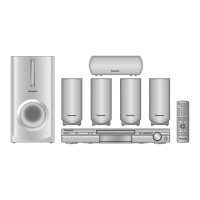
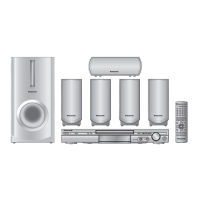
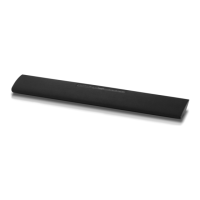
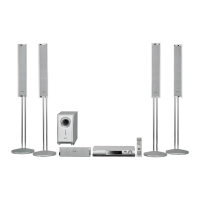
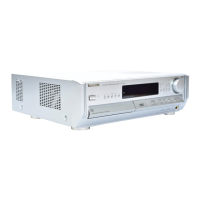
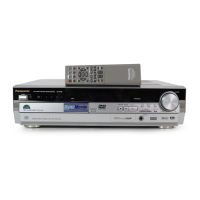
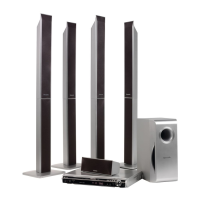
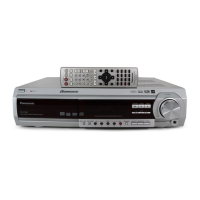
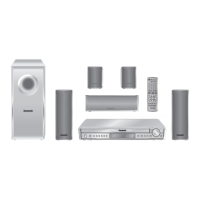
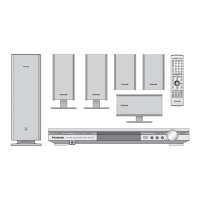

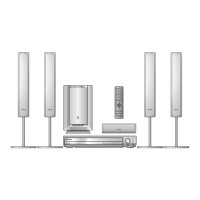
